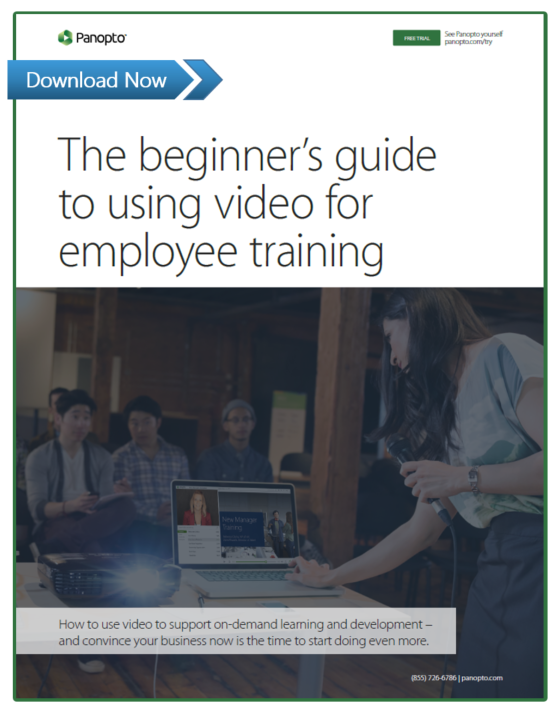- Onboarding
5 Ways Using Video in Employee Training Helps Build a Culture of Purpose

As business leaders reflect on last year’s results and implement improvement plans, the bottom line continues to be top priority. Yet as firms embrace new revenue streams and roll out new cost-savings initiatives, all too many overlook another internal investment that has proven to boost results — their people.
As a recent Deloitte survey shows, developing a business culture focused on purpose along with profits can help give companies the edge over their competitors. A strong sense of purpose boosts business confidence and confidence is infectious, attracting talent, encouraging investment and fuelling growth.
How Do Companies Create A ‘Culture Of Purpose’?
Effective training is vital, to ensure employees understand your company’s mission. 77% of employees surveyed by Deloitte believe ongoing training helps to achieve that all-important sense of purpose. But not all training methods are created equal — research suggests as much as 11% of employee training may be “unproductive learning”.
How much could you save
with video-based e-learning?
Calculate Your Savings
Traditional employee training methods are often ineffective (manuals fall out of date soon after they’ve been produced), expensive (upwards of half the cost of off-site seminars is spent on travel alone), or incomplete (as senior employees are not always available to share their expertise) — and sometimes all three. Add to this a cubicle culture in which workers feel disconnected from management decisions and you have a recipe for disillusionment and high staff turnover.
Technology, especially video, is addressing these challenges by revolutionizing the way knowledge is shared and used. Using new software Learning and Development professionals can reach more people, more effectively than ever before. Improving access to information not only equips staff with the skills needed to achieve personal and organizational goals, but also fosters an open culture with a shared sense of purpose.
Here are 5 ways using video in employee training can help your company transform its culture.
1. Speed up onboarding
For new hires to hit the ground running, managers need to quickly communicate large amounts of information. But with remote working and packed schedules, it’s not always possible to get recruits in the same room for face-to-face training. Instead, live streaming training sessions offers a cost-effective way to reach a large audience, offering the ability to communicate values and share up-to-date knowledge so that employees reach productivity quicker. Likewise, an on-demand video training library can help boost new employees’ confidence by giving them instant access to refresh and deepen learning.
2. Improve staff development
In most organizations, every position has at least a handful of unique requirements and expectations. But most traditional training programs don’t incorporate tailored learning, and often, company experts are often too busy to deliver sessions and outline all those particular details. By using video, forward-looking businesses allow employees to learn at their own speed and focus on areas of weakness. A video content management system like Panopto also modernizes the concept of social learning — employees can record presentations and best practice demonstrations, then store them securely where they can be shared and discovered by colleagues whenever needed.
3. Motivate and enable top talent
Experienced staff are a company’s most valuable resource — and keeping them on-mission is critical. Technology can help, by providing tools to help bosses manage their time and employees effectively. Briefings and updates can be recorded ahead of time and shared more widely on-demand, reducing the need to spend time in meetings. Maximizing the contribution of your most talented employees raises the bar for all, creating brand ambassadors with a strong and infectious sense of purpose.
4. Promote transparency
A more open culture allows an organization’s sense of purpose to thrive. Staff need to be kept abreast of developments in order to feel part of the team. Video can improve corporate communications, connecting employees to decisions made at a senior level. Video is even beneficial for day-to-day communications — in a world where Forrester Research reports employees are 75% more likely to watch a video than read text, a video can be a more effective means to share a message and stand out in an overflowing inbox.
5. Encourage innovation
Closed-door cultures often stifle innovation. And who says only executives know what is best for a company? Video can be used to harness inspiration by creating a forum where employees share their thoughts on company policy or strategy changes. Software like Panopto allows videos to be searched to pinpoint details in the feedback. This is important on two levels — first, by giving the organization a means to seek collect and preserve ideas from any department or level all across the company, and second, by demonstrating to staff that the organization values their thoughts and contributions (itself a proven technique to increase employee loyalty and morale).
The positive impact made by empowered staff on company performance is one that leaders are already well aware of. According to this Forbes report more than 70% of organizations believe the problem of employee “capability gaps” is one of the most important they face. The digital revolution continues to advance the way information is shared and used, and platforms like Panopto offer powerful solutions to support corporate training and development challenges.
Learn More About Using Video For Training
 In our complete white paper, The Beginner’s Guide To Using Video For Employee Training, we help L&D practitioners make the business case for doing more with video, including:
In our complete white paper, The Beginner’s Guide To Using Video For Employee Training, we help L&D practitioners make the business case for doing more with video, including:
- 5 benefits that help convince your decision makers to use video in more ways for L&D
- 14 ideas for supporting and scaling formal and informal learning with video
- 1 technology — the video platform — that simplifies the use of video for L&D
Today’s learning and development professionals already understand the potential that video technology offers. Make sure your organization isn’t missing out!


